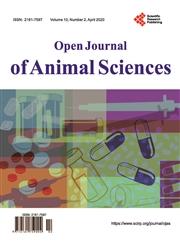Effect of Stabilized Fish Oil Source on Sperm Quality and Production of Boars
引用次数: 1
Abstract
Research findings for supplementing boar stud diets with fish oils are inconsistent. This study was designed to address three possible causes of performance variation of boars to fish oil supplementation: stability of the fatty acid source, level of inclusion and breed of boars tested. Three groups of 87 boars each, from two genetic lines (PIC 337 and PIC 800), were assigned to treatment based on age, mean sperm production (previous 12 weeks), and body condition score. All boars received a corn-soybean meal diet with a commercial fish oil supplement providing 1.83 g/boar/day of docosahexaenoic acid (DHA) as a preconditioning diet. On 10-Aug., 2020, the DHA source was changed to a stabilized starch imbedded source of refined fish oil (Salmate®), providing 1.83 g/b/d for the test diet. Two additional levels providing 2.38 and 2.94 g/b/d of DHA were fed for a 9 week pretreatment period and during the test period. Salmate® fed at 2.38 g/b/d of DHA resulted in a reduction in the number of rejected ejaculates (P 0.045) by 7.5% and 6.4% compared to the lowest and highest inclusion rates, respectively. There were no treatments by genetic line interactions. A retrospective study of semen production and quality of 77 boars on the Salmate® diet containing 1.83 g/b/d DHA was done to compare to the original source of DHA at the same inclusion level. There were no differences in semen quality parameters between the 2 lipid sources. Ejaculate volume increased from 177.9 ml to 233.4 ml (P 0.001) and total sperm cells per ejaculate increased from 69.7 × 109 to 82.0 × 109 (P 0.001) due to substitution of Salmate®. Adding Salmate® at 2.38 g/b/d resulted in a lower number of rejected ejaculates per boar by 7.5% and 6.4% vs. 1.83 and 2.94 g/b/d, respectively, and boars fed Salmate® at 1.83 g/b/d produced 17% more doses than the competing product.稳定鱼油来源对猪精子质量和产量的影响
关于在种公猪日粮中添加鱼油的研究结果并不一致。本研究旨在解决3个可能导致公猪对鱼油添加性能变化的原因:脂肪酸来源的稳定性、添加水平和被试公猪的品种。来自两个遗传系(PIC 337和PIC 800)的3组公猪,每组87头,根据年龄、平均精子产量(前12周)和身体状况评分进行处理。所有公猪均饲喂玉米-豆粕型饲粮,并添加1.83 g/头猪/天二十二碳六烯酸(DHA)的商业鱼油作为预处理饲粮。10-Aug。到2020年,将DHA来源改为稳定淀粉包埋的精制鱼油(Salmate®)来源,为试验日粮提供1.83 g/b/d。在9周的预处理期和试验期内,分别饲喂DHA含量为2.38和2.94 g/b/d的另外两个水平。在盐酸盐中添加2.38 g/b/d的DHA,与添加率最低和最高的盐酸盐相比,拒绝射精的数量分别减少了7.5%和6.4% (P 0.045)。没有遗传系互作处理。本研究对77头公猪在添加1.83 g/b/d DHA的盐盐®饲粮中精液产量和质量进行了回顾性研究,并与原饲粮中DHA添加水平相同的情况下进行了比较。两种脂质来源的精液质量参数无差异。由于Salmate®的替代,射精量从177.9 ml增加到233.4 ml (P 0.001),每次射精的精子细胞总数从69.7 × 109增加到82.0 × 109 (P 0.001)。与1.83 g/b/d和2.94 g/b/d相比,添加2.38 g/b/d的盐酸盐®可使每头公猪的拒绝射精量分别降低7.5%和6.4%,而饲喂1.83 g/b/d的盐酸盐®的公猪的拒绝射精量比同类产品多17%。
本文章由计算机程序翻译,如有差异,请以英文原文为准。
求助全文
约1分钟内获得全文
求助全文

 求助内容:
求助内容: 应助结果提醒方式:
应助结果提醒方式:


